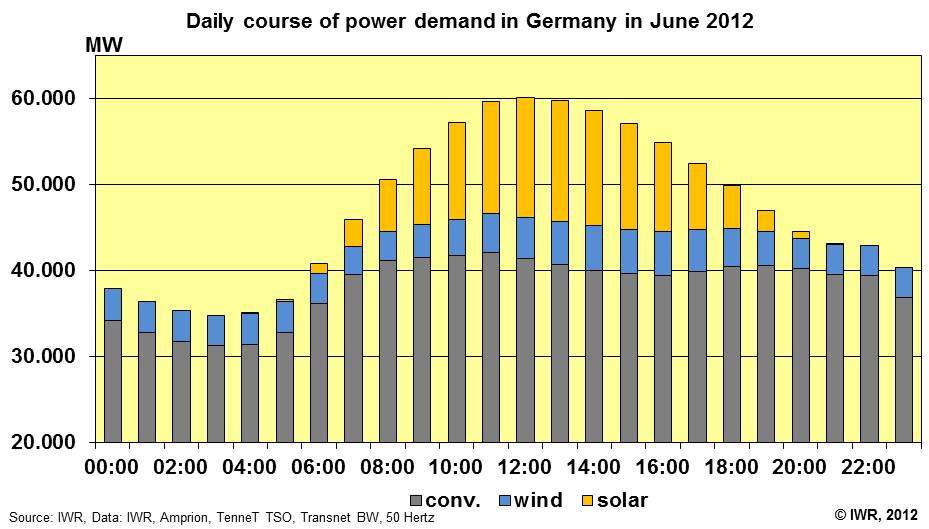Solar energy is unreliable and the sun does not shine at night anyway. Then conventional power plants have to take over again.
Facts
The fact is that conventional power plants simply do not have to take up the slack for solar energy at night. People forget that in the evening and at night demand for power declines and falls by a half in comparison to daytime requirements. During the day, photovoltaic plants produce the power needed to meet demand at that point during the day:
1. Daily course of demand for power and of power plant needs
Every day, the demand for power in Germany follows the same pattern. The demand for electricity and thus the need for power plant output is at its lowest at night around 3 am to 4 am. At the start of a day, demand for power increases and reaches its maximum at midday. Afterwards, the demand for power and required power plant output gradually declines, until the minimum requirement is again achieved at night.
For the required power plant output (see diagram), this means that the minimum required power plant output (on working days 35,000 MW to 40,000 MW) represents the lower threshold at night, with the power plants operating around the clock (base load).
The additional demand for power triggered by the rising demand for electricity of households and industry during the day is within a range of 20,000 to 25,000 MW and requires the successive addition of further power plant output, e.g. coal-fired power plants. In Germany, the peak load requirement (normally with gas-fired power plants), i.e. the maximum demand for electricity around midday, is about 60,000 to 65,000 MW in summer, and about 70,000 MW in winter.

2. Peak load: Solar energy provides power when it is needed
Figuratively speaking, the daily course of demand for power describes a bell curve, with the upper part of the bell corresponding to the power plant output additionally required in comparison to the night-time level. To cover this additional demand, more and more conventional power plants, such as coal or gas-fired power plants, are normally added until midday, and these are then gradually turned off again during the afternoon due to the decrease in the demand for electricity.
Today, the additional power plant output can largely be covered with the aid of solar power (yellow bars) and wind energy plants (blue bars). Solar energy has shown itself to be especially reliable, since the photovoltaics rises and falls parallel to the daily course of demand for power in Germany. And not just when the sun is shining brightly. Even on cloudy days, the contribution of solar energy to the peak load at midday reaches an output of 10,000 MW and more, while on sunny days up to over 20,000 MW is even possible. The need for conventional power plants (grey bars) falls tangibly due to the use of renewable energy.
Links
1. Record: Wind farms and solar power plants produce more power than conventional power plants , IWR press release 18-04-2013
2. World Record: German solar systems produce electricity with a capacity of more than 20,000 MW for the first time, IWR press release v. 26.05.2012
2. Wind, solar and conventional power plant forecast and actual power production on the EPEX
© IWR 2024
All rights reserved
Reproduction only with permission of the IWR /IWR.de GmbH



